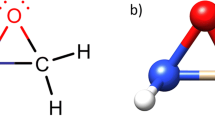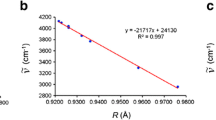Abstract
The title compound, C6H4N4S2·C3H7NO, crystallizes in the monoclinic space group C 2/c with a = 26.673(5), b = 5.397(1), c = 16.522(3) Å, β = 95.49(3)°, Z = 8, R = 0.0461 for 1891 reflections with I > 2σ(I) and 174 parameters (4 restraints). Single pteridine-2,4(1 H,3 H)-dithione and dimethylformamide molecules are packed via N-H···O and N-H···N hydrogen bonds into centrosymmetric clusters containing two molecules of each class; these are roughly planar and placed into two different sets of planes -both containing the [−1,0,2] direction- mutually angled by 77.8°. Despite the distance between two neighbor planes in each set is ca. 3.4 Å, the analysis of π,π-stacking interactions shows too large slippage distance between aromatic rings from contiguous planes. Additional σ-π interactions between S2, S4 and O1S atoms and pyrazine or pyrimidine rings from adjacent molecules are present. The structure for the cluster [DTLM-DMF]2 has been simulated by using the density functionals B1B95 (6-31 G(d) and 6-31+G(d) basis sets) and M06-2X (6-31 G(d) basis set). As a result, the M06-2X/6-31 G(d) approach provides the best agreement with the experimental XRD data. For a better evaluation of the intermolecular interactions, the superposition of two dimeric adducts [DTLM-DMF]2 has been modelized. The binding capability of DTLM ligand was simulated on systems containing two metal-binding modes to palladium (N5-S4 and N1-S2) with different chelate size. The analysis of the frontier orbitals points out that the link with the metallic centers will take place through the sulfur atoms.









Similar content being viewed by others
References
Milstien S, Kapatos G, Levine RA, Shane B (2002) Chemistry and Biology of Pteridines and Folates, Proceedings of the 12th International Symposium on Pteridines and Folates. Kluwer, Boston, pp 60–139
Taylor EC (1993) Chemistry and Biology of Pteridines and Folates. In: Ayling JE, Nair MG, Baugh CM (eds) Advances in experimental medicine and biology, vol 338. Plenum, New York, pp 387–408
Prins LHA, Petzer JP, Malan SF (2009) Bioorg Med Chem 17:7523–7530
Ding Y, Girardet JL, Smith KL, Larson G, Prigaro B, Lai VCH, Zhong W, Wu JZ (2005) Bioorg Med Chem Lett 15:675–678
Gomtsyan A, Didomenico S, Chih-Hung L, Stewart AO, Bhagwat SS, Kowaluk A, Jarvis MF (2004) Bioorg Med Chem Lett 14:4165–4168
Schneider HJ, Pfleiderer W (1974) Chem Ber 107:3377–3394
Acuña-Cueva ER, Hueso-Ureña F, Jiménez-Pulido SB, Moreno-Carretero MN (2000) J Mol Model 6:433–437
Acuña-Cueva ER, Jiménez-Pulido SB, Moreno-Carretero MN (2002) J Mol Model 8:246–252
Acuña-Cueva ER, Faure R, Jiménez-Pulido SB, Moreno-Carretero MN, Peña-Ruiz T (2004) J Mol Struct 697:65–71
Pfleiderer W (1974) Comprehensive Heterocyclic Chemistry, vol. 3-2B. Pergamon, Oxford, p 309
Brown DJ (1988) In: Taylor EC (ed) Fused pyrimidines: pteridines, vol 24(3). Wiley, New York, pp 445–509
Sheldrick GM (2003) SADABS. University of Göttingen, Göttingen
Farrugia L (1999) J Appl Crystallogr 32:837–838
Sheldrick GM (1997) SHELXL97. University of Göttingen, Göttingen
Spek AL (2003) J Appl Crystallogr 36:7–13
Cambridge Crystallographic Data Centre MERCURY (2002).Cambridge, England
Frisch MJ, Trucks GW, Schlegel HB, Scuseria GE, Robb MA, Cheeseman JR, Montgomery JA, Vreven T, Kudin KN, Burant JC, Millam JM, Iyengar SS, Tomasi J, Barone V, Menucci G, Cossi M, Scalmani G, Rega N, Petersson GA, Nakatsuji H, Hada M, Ehara M, Toyota K, Fukuda R, Hasegawa J, Ishida M, Nakajima T, Honda Y, Kitao O, Nakai H, Klene M, Li X, Knox JE, Hratchian HP, Cross JB, Bakken V, Adamo G, Jaramillo J, Gomperts R, Stratmann RE, Yazyev O, Austin AJ, Cammi R, Pomelli C, Ochterski JW, Ayala PY, Morokuma K, Voth GA, Salvador P, Dannenberg JJ, Zakrzewsky VG, Dapprich S, Daniels AD, Strain MC, Farkas O, Malick DK, Rabuck AD, Raghavachari K, Foresman JB, Ortiz JV, Cui Q, Baboul AG, Clifford S, Ciolowski J, Stefanov BB, Liu G, Liashenko A, Piskorz P, Komaromi I, Martin RL, Fox DJ, Keith T, Al-Laham MA, Peng CY, Nanayakkara A, Challacombe M, Gill PMW, Johnson B, Chen W, Wong MW, Gonzalez C, Pople JA (2004) Gaussian 03, Revision E.01. Gaussian Inc, Wallingford, CT
Becke AD (1993) J Chem Phys 98:5648–5652
Becke AD (1996) J Chem Phys 104:1040–1046
Lee C, Yang W, Parr RG (1988) Phys Rev B 37:785–789
Riley KE, Op’t Holt BT, Merz KM (2007) J Chem Theory Comput 3:407–433
Zhao Y, Truhlar DG (2008) Theor Chem Acc 120:215–241
Head-Gordon M, Pople JA, Frisch MJ (1988) Chem Phys Lett 153:503–506
Ditchfield R, Hehre WJ, Pople JA (1971) J Chem Phys 54:720–723
Clark T, Chandrasekhar J, Spitznagel GW, Schleyer PVR (1983) J Comput Chem 4:294–301
Woon DE, Dunning TH (1993) J Chem Phys 98:1358–1371
Kendall RA, Dunning TH, Harrison RJ (1992) J Chem Phys 96:6796–6806
Peterson KA, Figgen D, Dolg M, Stoll H (2007) J Chem Phys 126:124101–124112
Csaszar P, Pulay P (1984) J Mol Struct THEOCHEM 114:31–34
Farkas Ö, Schlegel HB (1999) J Chem Phys 111:10806–10814
Simon S, Duran M, Dannenberg JJ (1996) J Chem Phys 105:11024–11031
Boys SF, Bernardi F (1970) Mol Phys 19:553–566
Bader RF (1990) Atoms in molecules: a quantum theory. Oxford University Press, Oxford
Biegler-König F, Schönbohm J, Bayles D (2001) J Comput Chem 22:545–559
Koch U, Popelier PLA (1995) J Phys Chem 99:9747–9754
Allen FH, Watson DG, Brammer L, Orpen AG, Taylor R (2006) In: Prince E (ed) International Tables for Crystallography, vol C, ch 9.5. Springer, Heidelberg, pp 790–811
Takechi H, Kubo K, Takahashi H, Matsumoto T (2007) Acta Crystallogr E 63:o701–o703
Janik A, Olech A, Stasiewicz-Urban A, Stadnicka K (2009) Acta Crystallogr C 65:o70–o75
Yang KB, Lin LR, Huang RB, Zheng LS (2006) Acta Crystallogr E 62:o1938–o1940
Swaminathan S, Chacko KK (1978) Acta Crystallogr B 34:3108–3110
Hueso-Ureña F, Jiménez-Pulido SB, Moreno-Carretero MN, Quirós-Olozábal M, Salas-Peregrín JM (1998) Polyhedron 18:85–91
Janiak C (2000) J Chem Soc Dalton Trans 3885–3896
Varadwaj PR, Marques HM (2010) Theor Chem Acc 127:711–725
Acknowledgments
Thanks are due to “Plan de Apoyo a la Investigación, al Desarrollo Tecnológico y a la Innovación” of the University of Jaén (project RFC/PP2008/UJA-08-16-08) and Junta de Andalucía (FQM-273) for financial support. Also, the “Centro Informático Científico de Andalucía” (CICA) is acknowledged for computational facilities.
Author information
Authors and Affiliations
Corresponding author
Electronic supplementary material
CCDC-756140 contains the full crystal data for the reported XRD structure. These data can be obtained free of charge at the Cambridge Crystallographic Data Centre CCDC, 12 Union Road, Cambridge, CB2 1EZ, UK (fax: +44-1233-336-033; e-mail: deposit@ccdc.cam.ac.uk or http://www.ccdc.cam.ac.uk/conts/retrieving.html).
ESM 1
(TXT 11 kb)
ESM 2
(PDF 1630 kb)
ESM 3
(TXT 17 kb)
Rights and permissions
About this article
Cite this article
Illán-Cabeza, N.A., Peña-Ruiz, T. & Moreno-Carretero, M.N. XRD and DFT-modelized structures of a pteridine-2,4(1H,3H)-dithione/N,N′-dimethylformamide H-bonded cluster (2:2). MO study of the coordination ability. J Mol Model 18, 815–824 (2012). https://doi.org/10.1007/s00894-011-1109-1
Received:
Accepted:
Published:
Issue Date:
DOI: https://doi.org/10.1007/s00894-011-1109-1




